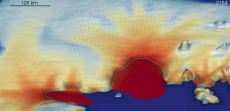Ice Sheet Model Reveals Most Comprehensive Projections for West Antarctica’s Future
BISICLES Simulations Help Estimate Ice Loss, Sea Level Rise
August 18, 2015
Contact: Linda Vu, +1 510 495 2402, lvu@lbl.gov
A new international study is the first to use a high-resolution, large-scale computer model to estimate how much ice the West Antarctic Ice Sheet could lose over the next couple of centuries, and how much that could add to sea-level rise. The results paint a clearer picture of West Antarctica’s future than was previously possible. The study is published today in The Cryosphere, a journal of the European Geosciences Union.
“The novel aspect of our work is the use of a high-resolution ice-sheet model over a larger area and longer time-scale than previously attempted. Much like a higher-resolution digital camera transforms a blur into a flock of birds, higher resolution in a computer model often helps to capture details of the physics involved which may be crucial to the broad picture,” says co-author Daniel Martin from the Lawrence Berkeley National Laboratory (Berkeley Lab).
West Antarctica is one of the fastest warming regions on Earth and its ice sheet has been stage to dramatic thinning in recent years. The West Antarctic Ice Sheet (WAIS) is out of balance because it is losing significant amounts of ice to the ocean, with the losses not being offset by snowfall.
“The IPCC’s [Intergovernmental Panel on Climate Change] 4th and 5th Assessment Reports both note that the acceleration of West Antarctic ice streams in response to ocean warming could result in a major contribution to sea-level rise, but that models were unable to satisfactorily quantify that response,” says Stephen Cornford from University of Bristol, UK and lead-author of the study.
Using an ice sheet model—called Berkeley-ISICLES (BISICLES)—Martin, Cornford and collaborating researchers from around the world have now estimated how much the WAIS could contribute to global sea-level rise over the next couple of centuries. These comprehensive high-resolution simulations are a significant improvement from previous calculations, which were lower in resolution or scale, allowing researchers to make more accurate predictions about West Antarctica’s future.
Some of the BISICLES simulations were performed on the National Energy Research Scientific Computing Center’s (NERSC’s) Hopper and Edison systems, which are located at Berkeley Lab.
For more information on the ice sheet model:
http://crd.lbl.gov/news-and-publications/news/2013/berkeley-code-captures-retreating-antarctic-ice/
For more information on the results see:
http://www.egu.eu/news/188/most-comprehensive-projections-for-west-antarcticas-future-revealed/
About Berkeley Lab
Founded in 1931 on the belief that the biggest scientific challenges are best addressed by teams, Lawrence Berkeley National Laboratory and its scientists have been recognized with 16 Nobel Prizes. Today, Berkeley Lab researchers develop sustainable energy and environmental solutions, create useful new materials, advance the frontiers of computing, and probe the mysteries of life, matter, and the universe. Scientists from around the world rely on the Lab’s facilities for their own discovery science. Berkeley Lab is a multiprogram national laboratory, managed by the University of California for the U.S. Department of Energy’s Office of Science.
DOE’s Office of Science is the single largest supporter of basic research in the physical sciences in the United States, and is working to address some of the most pressing challenges of our time. For more information, please visit energy.gov/science.










